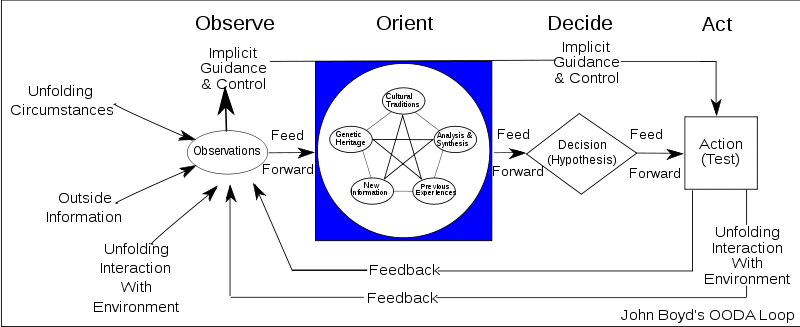Addressing the Feedback Loops in OODA
- by 7wData

I have spent the last several days searching for a YouTube video, information that discusses the feedback loops that are contained in this drawing of the OODA loop:
It seems when most people discuss OODA, they spend most of their time talking about Observe-Orient-Decide-Act. Often they compare the process to PDCA which I disagree with as I believe it is the process of CAP-Do. A brief summary from my past writings:
The OODA Loop when observed is actually the CAP-Do cycle when applied to Lean Language. The strength of OODA Loop is in the first two steps, Observe and Orientate. Just as Check and Act are in CAP-Do. In Boyd’s terminology, the D in the OODA Loop stands for Decision or formulating the Plan to carry out the Hypothesis. He uses A, act to perform the Hypothesis or the Do cycle. I believe CAP-Do, the OODA Loop, is the best way to apply Lean in an external environment.
Through all the information, I plowed through maybe not so surprisingly a quote from John Boyd himself summed up the feedback loops better than anything else. An excerpt from the article, The Strategy of the Fighter Pilot written by: Keith H. Hammonds for Fast Company:
Systems like Toyota’s worked so well, Boyd argued, because of Schwerpunkt, a German term meaning organizational focus. Schwerpunkt, Boyd wrote, “represents a unifying medium that provides a directed way to tie initiative of many subordinate actions with superior intent as a basis to diminish friction and compress time.” Employees decide and act locally, but they are guided by a keen understanding of the bigger picture. In effective organizations, Schwerpunkt connects vibrant OODA loops that are operating concurrently at several levels. Workers close to the action stick to tactical loops, and their supervisors travel in operational loops while leaders navigate much broader strategic and political loops. The loops inform each other: If everything is clicking, feedback from the tactical loops will guide decisions at higher loops and vice versa.
I would assume from this article the idea of the most inner feedback loop contained in the diagram above would be the tactical loop, operational loops would be the middle feedback loop and outer loop the strategic and political loops. As I worked through the process of trying to find more information about the feedback loops I found a dissertation from Chet Richards on the Implicit Guidance & Control (IG & C) Box:
The primary reason for implicit guidance when engaged with opponents is that explicit instructions-written orders, for example-would take too much time. As Boyd (1987a) put it, “The key idea is to emphasize implicit over explicit in order to gain a favorable mismatch in friction and time (i.
[Social9_Share class=”s9-widget-wrapper”]
Upcoming Events
Shift Difficult Problems Left with Graph Analysis on Streaming Data
29 April 2024
12 PM ET – 1 PM ET
Read MoreCategories
You Might Be Interested In
The story of smart data
5 Apr, 2019With the internet of things (IoT) we’ve realized that we can amass data from our sensors, smart objects or “things” …
Recent Jobs
Do You Want to Share Your Story?
Bring your insights on Data, Visualization, Innovation or Business Agility to our community. Let them learn from your experience.
Privacy Overview
Get the 3 STEPS
To Drive Analytics Adoption
And manage change




